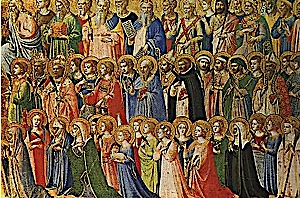Image:The Forerunners of Christ with Saints and Martyrs by Fra Angelico
Pope Francis’ address to the conference of the dicastery for the causes of saints
Clementine Hall – Thursday, 16 November 2023
‘The community dimension of holiness’
Dear brothers and sisters,
This theme of the universal call to holiness, and within it, its community dimension, is very dear to Vatican Council II, which spoke about it specifically in Lumen gentium (cf. Chapter V).
It is not a coincidence, in this regard, that in recent years there has been an increase number of beatifications and canonizations of men and women belonging to different states of life: married men and women, the celibate, priests, consecrated women and men and laypeople, families – think of the martyrs of Poland – of every age, origin and culture. In particular, in Gaudete et exsultate, I wished to draw attention to the fact that all these brothers and sisters belong to the “holy faithful people of God” (no. 6); as well as to their closeness to us, as saints “next door” (no. 7), members of our communities, who have lived with great charity in the small things of daily life, even with their limitations and faults, following Jesus to the end.
Therefore, I would now like to reflect with you on this very theme, highlighting three aspects of it, among the many possible: holiness that unites, family holiness and martyrdom. Holiness that unites, family sanctity and martyr holiness.
First: holiness that unites.
We know that the vocation to which we are all called is fulfilled first of all in charity (cf. Lumen gentium, 40), which is a gift of the Holy Spirit (cf. Rom 5:5) that unites us in Christ and with our brothers and sisters: it is , therefore, not only a personal event, but also a communitarian one.
When God calls an individual, it is always for the good of all, as in the case of Abraham and Moses, Peter and Paul. He calls the individuals for a mission. Finally, just as Jesus, the Good Shepherd, calls each of his sheep by name and seeks out the lost one to bring him back to the fold. The response to His love cannot but be a dynamic of commmitment and intercession.
The Gospel shows us this, for example for in Matthew who, as soon as he is called by Jesus, invites his friends to meet the Messiah or for in Paul who, having met the Risen One, becomes the Apostle to the Gentiles.
The encounter with Jesus has this communitarian dimension.
This reality is expressed in a particularly moving way by Saint Thérèse of the Child Jesus, to whom I dedicated the Apostolic Exhortation C’est la confiance, on the 150th anniversary of her birth,.
In her writings, with an evocative biblical image, she contemplates the whole of humanity as the “garden of Jesus”, whose love embraces all its flowers in a way that is both inclusive and exclusive, and asks to be set aflamed by the fire of such love, so that she may lead all her brothers and sisters to it.
This is evangelization “by attraction”. It is witness: it is at the same time the fruit of the supreme mystical experience of personal love and of the “’mystique’ of living together”.
In it, the two modes of the Lord’s presence are interpenetrated, both in the interior of the individual person, and in the midst of those gathered in his name; in the “castle of the soul” and in the “castle of the community”, to use an image dear to Saint Teresa of Ávila in “The Interior Castle”.
Holiness unites, and through the charity of the saints we can know the mystery of God who “united himself with every man” and embraces all humanity in his mercy, so that all may be one.
How much our world needs to find unity and peace in such an embrace! We need this…
Secondly: Let us move on to the second point: family sanctity.
It shines eminently in the Holy Family of Nazareth.. And yet the Church today offers us many other examples: “In many holy marriages too, each spouse becomes a means used by Christ for the sanctification of the other”. Let us think of Sts. Louis and Zelia Martin; Blessed Louis and Maria Beltrame Quattrocchi; Venerable Tancredi and Julia of Barolo; Venerable Sergio and Domenica Bernardini.
The sanctity of the spouses, as well as the particular sanctity of two different persons, is also common sanctity in marriage: hence the multiplication – and not a mere addition – of the personal gift of each one that is communicated.
And a shining example of this was recently offered to us in the beatification, which I mentioned at the beginning, of the couple Jozef and Wiktoria Ulma and their seven children: all martyrs.
They, too, remind us that “growth in holiness is a journey in community, side by side with others”, and not alone. Always to be done with the community.
Thirdly: And so we come to the third point: martyr holiness.
It is a powerful model, of which we have many examples throughout the history of the Church, from the first communities up to the modern age, throughout the course of the centuries and in different parts of the world.
There is no period that has not had its martyrs, up to our time. And we think that these martyrs are something that does not exist… but think of a case of Christian life lived in continuous martyrdom: the case of Asia Bibi, who was in prison for many years, and her daughter brought her the Eucharist…
And many years passed before the moment when the judges said she was innocent. Nearly nine years of Christian witness!
She is a woman who continues to live, and there are many, many like her, who bear witness to faith and charity.
And let us not forget our time, which has had many martyrs!
Often, they are “whole communities who have lived the Gospel heroically or who have offered to God the lives of all their members” (ibid.).
And the matter broadens even broader if we consider the ecumenical dimension of their martyrdom, remembering those who belong to all Christian denominations.
Let us think, for example, of the group of twenty-one Coptic martyrs recently included in the Roman Martyrology. They died saying “Jesus”, “Jesus”, “Jesus”, on the beach….
Dear brothers and sisters, holiness gives life to the community, and you, through your work, help us to understand and celebrate its reality and dynamics ever better, in the many and varied ways that you study and propose for our veneration; different, but all directed towards the same goal: the fullness of love. This is the way of holiness. I thank you very much for this, and I encourage you to continue your beautiful mission with joy, for the good of individuals and the growth of communities. I cordially bless you, and, please do not forget to pray for me.


